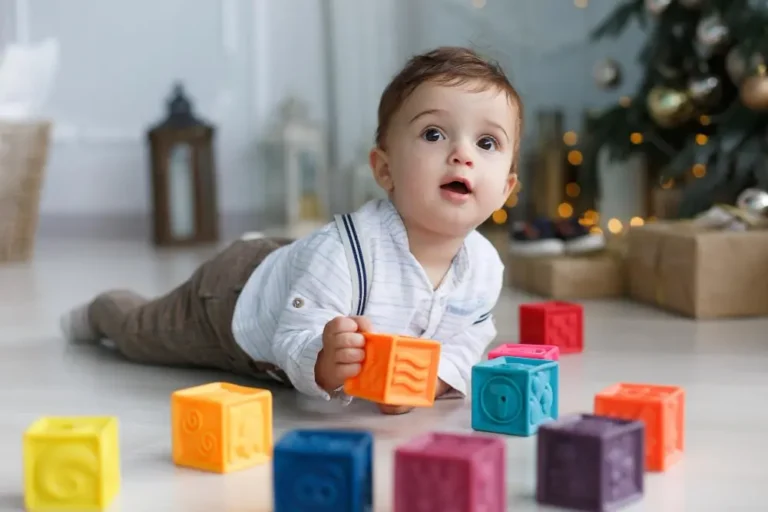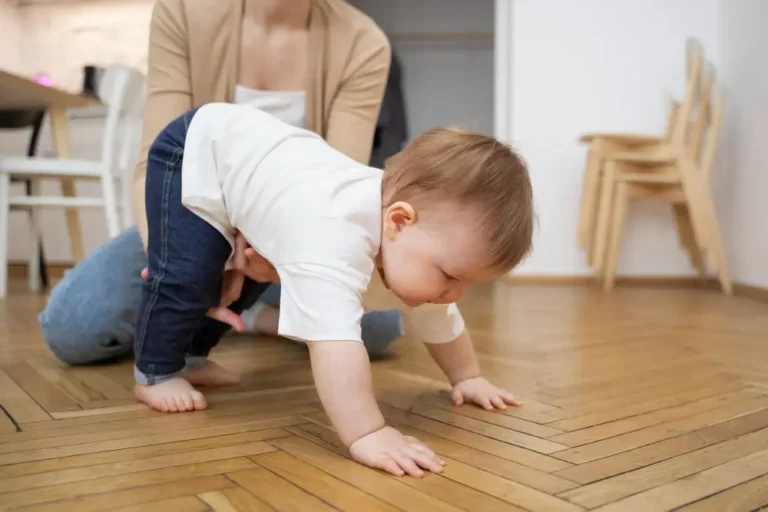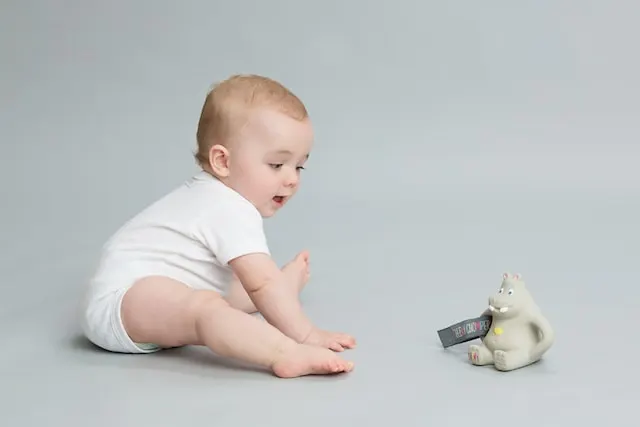All parents are excited to see their babies start crawling to discover the world around them, as it is considered to be the first effective milestone babies can achieve.
A crawling baby will feel some independence as he can get from one place to another by using his legs and arms simultaneously, and that baby will sometimes refuse any help from the parents.
In this blog post, we will discuss the following:
How do you encourage your baby during the “baby crawling” phase?
Precautions to consider during the baby crawling phase.
When do babies crawl?

Most babies will start crawling between 6 and 10 months old, but before that, they will show some signs that precede the crawling milestone, like:
- At 2 to 3 months old, babies can hold their heads up.
- At 4 months old, the baby’s neck muscles will become stronger, resulting in the baby lifting the head without much support and starting to roll left and right.
- At 6 months old, babies will try to sit by using their abdominal muscles.
Please note that babies do not achieve milestones at the same time, and this is due to genetic differences and the distribution of the calcium element throughout the body.
These reasons can have a direct impact on baby teething and the process of growing bones because some babies grow stronger bones and muscles way before teething, and vice versa.
Types of baby crawling.
Not all babies crawl in the same style, but the most common type is when a baby uses the left leg and right arm simultaneously and then changes to the other ones.
Normally, babies will crawl differently until they reach the ideal form of crawling. So here are some styles of how babies can crawl:
- Crawling by using the arms and abdominal muscles: some babies will just extend their arms and extend their backs and neck muscles to pull their bodies toward something.
- Scoot crawling: babies of this type will sit on their bottoms and push their hands against the floor or move their legs to lift their bottoms and move in some direction.
- Bear crawling: babies will have more power to use their arms and legs simultaneously by lifting their waist while moving.
- Backward crawling: babies will use their arms and legs to move their bodies backward, and that style will only exist at the beginning of learning crawling.
To see a better demonstration of crawling, kindly check out this video.
Some babies might skip crawling entirely and go directly to standing up and walking.
How do you encourage your baby during the “baby crawling” phase?

Parents can help and motivate a crawling baby to crawl more in so many ways, like:
- Some parents play online videos in front of their babies to teach them how other babies can crawl so they can imitate them.
- Many parents right now are starting to teach their babies how to swim with certified coaches because swimming will help babies balance their bodies and strengthen their muscles.
- When babies get stronger muscles, parents should begin some tummy time for a few minutes every day by placing their preferred toys in front of them so that babies can learn to crawl.
- Exposing babies to sunlight in the morning for 30 minutes is essential to gain vitamin D, which can help in absorbing calcium and thus strengthening the muscles.
- When babies try to crawl by using their arms only without their legs, try to move their legs gently forward and backward so that they can realize and feel their legs while doing the motion.
Precautions to consider during the baby crawling phase.

Parents should consider some safety precautions when babies start crawling, like:
- Buying baby safety products to cover sharp edges and to close drawers so babies do not hurt themselves while crawling.
- Assigning a specific and secure area for a crawling baby to practice crawling freely without worries
- Cleaning the house is necessary to prevent any type of infection or germs because babies normally lick their hands, which leads to fever.
- Covering all electric plugs that are within reach of your baby with plastic plugs
- Using a baby crib is important because when babies start crawling, they begin to change their sleep patterns.
- Removing any objects that babies can swallow during their learning of crawling.
- Securing the inner stairs of your house, if it has any, with wooden gates
When should I consult a doctor about crawling issues?
Many new parents have concerns about their baby not crawling, and they panic and go to a doctor for consultation.
What these parents do not know is that if the baby achieves other milestones, then there should be no worries, and these milestones are like:
- Turning their heads when their names are called.
- Making eye contact with the parents and babbling.
- Showing signs of baby teethingin general.
- Having control over their heads.
Parents should only start to worry and consult a specialist when their baby shows no interest in rolling over, sitting, or using her arms and legs to crawl.
As we mentioned before, some babies can skip the crawling milestone entirely and go straight to standing and then walking, and that case is real because my nephew did that.
What comes after crawling?
Now that you have a crawling baby, be ready for the following milestones:
- Teething: Babies grow teeth between 4 and 8 months.
- Walking: babies start walking between 10 and 16 months old.
- Climbing: babies will learn to climb when their arms, shoulders, and legs become stronger and when their parents place their toys on a couch or a bed.
- Running: Toddlers will begin learning to run between 18 and 24 months.
- Squatting: Toddlers will squat between 20 and 24 months, using their hands for support.
In conclusion:
The crawling stage is not an essential sign for a growing baby, according to the American Academy of Pediatrics
and that there is no harm in encouraging your baby to learn to crawl and trying to make the environment safe for your kid as per our recommendations, as this stage will introduce you to the next stage, the walking stage.
Now is your time to share with us the most beneficial tip by contacting us.

